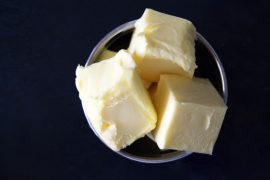Fragrance isn’t what you think it is. And it’s doing more harm than you realize. That stinks.
“Fragrance” (as listed in the U.S.) or “parfum” (as listed in the E.U. and Canada) is not a single chemical. It can be dozens or hundreds of chemical ingredients – up to 80 percent of which have never been tested for human toxicity.1 The terms are generic, somewhat misleading, and many people think they only refer to perfume and cologne. Unfortunately, these unlisted ingredients hiding behind “fragrance” that manufacturers like to call “trade secrets”2, are making some people sick and are building up in our environment.
How Fragrance Chemicals Can Harm You
Each day you inhale, ingest, and absorb through your skin a variety of toxic chemicals. It’s called your “body burden.” Over 3,100 fragrance chemicals are used to make your consumer products smell “fresh” or to mask unpleasant odors3; your shampoo and dryer sheets could be polluting your indoor air and giving you a rash!4

Many chemicals in “fragrance” are classified as toxic or hazardous, and even some with no exposure level that is considered safe.5 If you’ve experienced an allergic reaction, skin irritation, asthma attack, or migraines, it could be a result of the scented products you use.
The Environmental Working Group found that one in eight of the 82,000 ingredients used in personal care products are industrial chemicals, including carcinogens, pesticides, reproductive toxins, and hormone disruptors. And many cleaners contain harmful chemicals that have been linked to cancer, reproductive disorders, asthma, and severe allergies.6
In one research project, nearly half of the fragranced products emitted one or more carcinogenic “hazardous air pollutants” (e.g., 1,4-dioxane and formaldehyde)7. Neither has a safe exposure level, according to the U.S. Environmental Protection Agency. Research by Environmental Defence and the Environmental Working Group found an average of 10 sensitizing chemicals in perfumes, colognes, and body sprays that can trigger allergies and asthma, and cause headaches, wheezing, and a rash.
Stranger still is when Dr. Anne Steinemann found that even if a product doesn’t contain hazardous chemicals, it can generate them. Limonene (a citrus scent), for example, reacts with ozone in surrounding air to create a range of potentially hazardous secondary pollutants, such as formaldehyde, acetaldehyde, and ultrafine particles.7 The International Agency on Research on Cancer, World Health Organization, and the U.S. government all categorize formaldehyde as a known human carcinogen.
How Fragrance Chemicals Harm the Environment
“Fragrance” is among the top five allergens in the world8 and also harms fish and other wildlife.
Synthetic musks used in fragrances are the worst. They wash off your body, go down the drain and then hang around and build up in the fatty tissues of aquatic animals. Detectable levels (and they’re on the rise) of synthetic musks have been found in our Great Lakes’ fishes and sediments.9 Their negative impact isn’t a secret – Environment Canada calls musks persistent and bioaccumulative and/or toxic. These chemicals travel far and wide, don’t break down or go away, and are magnified as they work their way up the food chain. Synthetic musks are also found in human breast milk and body fat.10
The European Union has the strongest regulations for all fragrance chemicals, including restricting the use of two common musks. Manufacturers in the EU must also have warning labels on products if they contain any of 26 allergens commonly used as cosmetic fragrances.
Where to Find Fragrance
Despite your great label-reading skills, you won’t know which specific chemical ingredients make up the “fragrance” in a particular product. A loophole allows companies to lump all the chemicals they use – many derived from petroleum or made by chemical synthesis – as “fragrance” or “parfum” on product ingredient lists.11
All you can do is check for “fragrance” or “parfum” on your personal care products, often the last ingredient. Did you know the average woman uses 12 cosmetics products daily and six for men?12 Next, check your home cleaners. Home cleaning products aren’t required to disclose any ingredients6; some do so voluntarily, and your other clue is if it’s scented. Once you start looking for “fragrance,” you’ll see it’s everywhere, even in “fragrance-free” or “unscented” products. They may actually have a masking agent added, or use “fragrance” chemicals to hide odors.13
How to go Scent-Free
Take simple steps to avoid fragrance chemicals and improve your health and protect nature.
- Shop smarter. Avoid personal care products with “fragrance” or “parfum” on the label – one of the David Suzuki Foundation’s Dirty Dozen chemical ingredients to avoid in your cosmetics.14
- Beware of “unscented” and “fragrance-free” terms on the front of products because they may still contain “fragrance”! “Fragrance” must be absent from the ingredient list.
- Open a window to improve indoor air quality instead of air fresheners that mask the problem and worsen air quality.
- Rid your clothing and bedding of scents, wash them in a cup or two of baking soda, and then add white vinegar to the rinse cycle.
- Make some of your own nontoxic cosmetics and cleaners with food-grade ingredients that are effective, affordable, and void of fragrance chemicals.15
- Use natural scents like essential oils sparingly, as some people can react to them as well as synthetic “fragrance”.
- Ask if your workplace has a scent-free policy (they might and not even realize what it means!) or, encourage them to adopt a scent-free policy.
- Choose scent-free doctor and dentist offices, even salons.
Sources:
- http://www.davidsuzuki.org/blogs/science-matters/2010/04/what-are-you-putting-on-your-body/
- http://www.fda.gov/Cosmetics/ProductsIngredients/Ingredients/ucm388821.htm
- http://www.safecosmetics.org/wp-content/uploads/2015/02/Not-So-Sexy-report.pdf
- http://ec.europa.eu/health/scientific_committees/opinions_layman/perfume-allergies/en/index.htm
- http://www.ncbi.nlm.nih.gov/pubmed/19326669
- http://www.davidsuzuki.org/issues/health/science/toxics/the-dirt-on-toxic-chemicals-in-household-cleaning-products/
- Nazaroff WW, Weschler CJ. Cleaning products and air fresheners: exposure to primary and secondary air pollutants. Atmos Environ 38(18):2841-65, 2004.
- http://www.ewg.org/skindeep/top-tips-for-safer-products/
- http://www.cela.ca/sites/cela.ca/files/667IJC.pdf
- http://www.safecosmetics.org/get-the-facts/chemicals-of-concern/synthetic-musks/
- http://davidsuzuki.org/issues/health/science/toxics/fragrance-and-parfum/
- http://www.ewg.org/skindeep/2004/06/15/exposures-add-up-survey-results/
- http://www.hc-sc.gc.ca/cps-spc/pubs/indust/labelling_guide-etiquetage/index-eng.php#a101
- http://davidsuzuki.org/issues/health/science/toxics/dirty-dozen-cosmetic-chemicals/
- http://davidsuzuki.org/publications/resources/2011/green-cleaning-recipes/
Reprinted with permission from fix.com
 About the Author: Lindsay Coulter
About the Author: Lindsay Coulter










